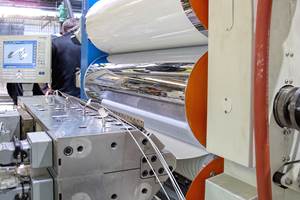The Limits Of Compression Ratio
Extrusion Know How
Don't rely just on this value during the screw design process.
You have probably heard the terms 2:1, 3:1, and so on in describing single screws. These numbers refer to the compression ratio (C/R) of the screw, which is the ratio of the feed depth to the metering depth. Most people use C/R as a method to select the proper feed depth of the screw, but it significantly impacts the melting rate as well.
While C/R should not be overlooked, there are a lot of other parameters to consider when designing the optimum feed and melting sections of a screw. The C/R does not tell you the channel depth or section length, just the ratio between them. Would you expect a screw with feed and metering depths of 0.900 in. and 0.300 in., respectively, to perform the same as one of the same size with depths of 0.450 in. and 0.150 in.? Or would you expect a screw with five feed flights to perform the same as one with 10 flights at the same depth? What if there is a pitch change between the feed section and metering section? These configurations can all have a 3:1 C/R, but for certain they will perform differently.
Feeding properties are hard to quantify and measure, so most screw designers necessarily use a largely empirical approach when making decisions. However, the best designers utilize a number of empirical relationships relating to the frictional characteristics of the individual polymer along with the particle characteristics of the individual application, such as bulk density, packing, and uniformity.
These vary by polymer, resin manufacturer, use of regrind, presence of additives or fillers, and feedthroat design. Screw designers will not rely on a single fixed ratio like C/R for each polymer, but one that varies to suit as many characteristics of the feed material and the feed-throat design as can be quantified.
The other aspect of C/R is that it affects the melting performance. That’s because C/R does not describe the rate of compression. For example, a 3:1 C/R will have a different compression rate if the compression section is five turns as opposed to 10. Different polymers—and even different grades of the same polymer—can require different rates of compression in order to optimize melting without plugging or breakup of the melting pattern.
The C/R alone does not provide that information. In addition, some polymers will experience a reduction in viscosity more than others under similar conditions of shear. This can require a different metering depth to control melt temperature, even though a target C/R has been met for the feed capacity. Consequently, the ideal feed and metering depth are seldom based simply on C/R.
Today many screws utilize a barrier section, which completely eliminates the need for any relationship between the feed depth and the metering depth. Since melting is controlled in the barrier section, the metering section can be designed to accommodate other aspects of the extrusion process, such as head pressure, melt temperature, and mixing, without affecting either the feed rate or the melting performance.
The use of “standard” C/Rs for certain polymers has resulted in many poorly designed screws. The shortcoming is usually in matching the melting rate to the polymer and output. A bad match can result in high screw wear, surging, poor melt quality, and poor mixing.
Related Content
How Polymer Melts in Single-Screw Extruders
Understanding how polymer melts in a single-screw extruder could help you optimize your screw design to eliminate defect-causing solid polymer fragments.
Read MoreRoll Cooling: Understand the Three Heat-Transfer Processes
Designing cooling rolls is complex, tedious and requires a lot of inputs. Getting it wrong may have a dramatic impact on productivity.
Read MoreHow to Select the Right Cooling Stack for Sheet
First, remember there is no universal cooling-roll stack. And be sure to take into account the specific heat of the polymer you are processing.
Read MoreWhy Are There No 'Universal' Screws for All Polymers?
There’s a simple answer: Because all plastics are not the same.
Read MoreRead Next
Lead the Conversation, Change the Conversation
Coverage of single-use plastics can be both misleading and demoralizing. Here are 10 tips for changing the perception of the plastics industry at your company and in your community.
Read MorePeople 4.0 – How to Get Buy-In from Your Staff for Industry 4.0 Systems
Implementing a production monitoring system as the foundation of a ‘smart factory’ is about integrating people with new technology as much as it is about integrating machines and computers. Here are tips from a company that has gone through the process.
Read MoreBeyond Prototypes: 8 Ways the Plastics Industry Is Using 3D Printing
Plastics processors are finding applications for 3D printing around the plant and across the supply chain. Here are 8 examples to look for at NPE2024.
Read More.jpg;width=70;height=70;mode=crop)












